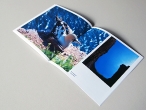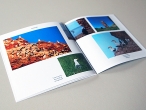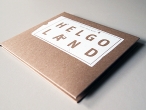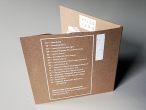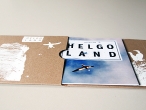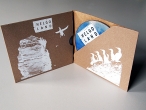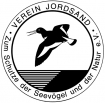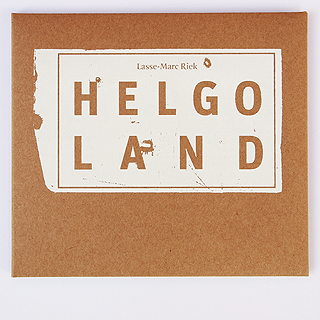
Helgoland | Lasse-Marc Riek
English | Deutsch
Gruen 109 | Audio CD > [order]
Text
Reviews
Germany’s only ocean island is a singular place in various ways. Situated 70 kilometers from the coast line, it belonged to the UK for 90 years during the 19th century. During World War II, the first facilities for a huge naval base were erected. The tunnels and bunkers from that time were blown up in 1947. In the following years, the island served as a training area for British bombers.
It is not know how the birds have survived this period of destruction. Yet, by the return of people to the devastated island in 1952, it had become more quiet for them, too. More than 370 different species have been counted since then, even though only few of them do actually breed in the island. Nevertheless, Helgoland is among the spots in Europe, that is most densely populated by birds. Within Germany, it is also the only place populated by marine birds like Common Murre, Northern Gannet, Northern Fulmar, Razorbill and Black-legged Kittiwake.
Today, ornithologists can approach the cliffs and caves, were thousands of birds breed, directly through the old tunnels. Lasse-Marc Riek was allowed to use these tracks in order to …
(Stefan Militzer)
01 Sand
Ort/Location: Hauptinsel-Nordoststrand, 01.12.2010, 16:36 Uhr
02 Brandung 01
Ort/Location: Düne-Nordstrand, 04.06.2010, 11:36 Uhr
MP3
03 Lummenfelsen
Trottellumme, Common Guillemot (Uria aalge),
Basstölpel, Northern Gannet (Morus bassanus)
Dreizehenmöwe, Black-legged Kittiwake (Rissa tridactyla)
Ort/Location: Hautpinsel-Lummenfelsen, 02.06.2010, 11:04 Uhr
MP3
04 Lummensprung
Trottellumme, Common Guillemot (Uria aalge)
Ort/Location: Hauptinsel-Lummenfelsen, 04.06.2010, 09:29 Uhr
05 Mole I
Ort/Location: Hauptinsel-Lummenfelsen, 19.07.2011, 14:53 Uhr
06 Basstölpel
Basstölpel, Northern Gannet (Morus bassanus)
Ort/Location: Hauptinsel-Lummenfelsen, 24.07.2011, 11:06 Uhr
MP3
07 Mole II
Grünes Heupferd, Great Green Bush-Cricket (Tettigonia viridissima)
Dreizehenmöwe, Black-legged Kittiwake (Rissa tridactyla)
Ort/Location: Hauptinsel-Nordwestmole, 19.07.2011, 15:38 Uhr
MP3
08 Dreizehenmöwe I
Dreizehenmöwe, Black-legged Kittiwake (Rissa tridactyla)
Ort/Location: Hauptinsel-Lummenfelsen, 20.07.2011, 11:20 Uhr
09 Mole III
Ort/Location: Hauptinsel-Nordwestmole, 19.07.2011, 10:15 Uhr
10 Dreizehenmöwe II
Heringsmöwe, Lesser Black-backed Gull (Larus fuscus)
Dreizehenmöwe, Black-Legged-Kittiwake (Rissa tridactyla)
Ort/Location: Hauptinsel-Lummenfelsen, 20.07.2011, 11:51 Uhr
11 Brandseeschwalbe
Brandseeschwalbe, Sandwich tern (Sterna sandvicensis)
Ort/Location: Düne-Südstrand, 24.07.2011, 10:13 Uhr
12 Heringsmöwe
Heringsmöwe, Lesser Black-backed Gull (Larus fuscus)
Ort/Location: Düne-Aade, 20.07.2011, 22:29 Uhr
13 Kegelrobbe / Jungbullen
Grey Seal (Halichoerus grypus)
Ort/Location: Düne-Aadestrand, 03.12.2010, 09:27 Uhr
MP3
14 Kegelrobbe / Jungtier
Kegelrobbe, Grey Seal (Halichoerus grypus)
Ort/Location: Düne-Flugplatz, 03.12.2010, 12:14 Uhr
MP3
15 Sturm
Kegelrobbe, Grey Seal (Halichoerus grypus)
Ort/Location: Düne-Aadestrand, 03.12.2010, 16:23 Uhr
16 Flugzeug- Kegelrobbe (Bulle)
Kegelrobbe, Grey Seal (Halichoerus grypus)
Ort/Location: Düne-Flugplatz, 03.12.2010, 02:31 Uhr
MP3
16 Tracks (47′01″)
CD (500 copies)
Many thanks for the friendly support go to Frank Gutzke. (Verein Jordsand zum Schutze der Seevögel und der Natur e.V.)
Thanks also to Cheryl Tipp, Stefan Militzer, Tobias Fischer, Janko Hanushevsky, Patrick Franke, Sebastian Ristow, Roland Etzin und Nora Grozdek.
For Anne, Matti und Elli.
Field Recording Series by Gruenrekorder
Germany / 2013 / Gruen 109 / LC 09488 / GEMA / EAN: 4050486090657
01 Cheryl Tipp
A place can inspire us in many different ways. Whether it be painting, photography, poetry or sound, all of these outputs are driven by a desire to preserve the essence or spirit of the landscape that has touched us. Lasse-Marc Riek chose the medium of sound to demonstrate his love for the natural history of Helgoland, a small German archipelago in the North Sea. Over the course of two years, Riek gathered together a series of field recordings that move from the majestic to the intimate. The delicate sweep of sand particles caught in the breeze sits alongside the harsher sounds of a passing storm battering the land with an unrelenting force. Some recordings demonstrate the overwhelming presence of seabird colonies, alive with the vocalisations of Black-legged Kittiwakes, Common Guillemots and Northern Gannets. This all-encompassing cacophony of growls, cackles and screeching calls creates an evocative and imposing sound picture, yet other recordings allow us to experience each of these species at closer quarters. We are able to listen in on the conversations of Black-legged Kittiwake and Northern Gannet families and experience the harsh cries of Arctic Terns calling to each other over the sound of crashing waves. One of the most moving recordings captures guillemot chicks taking to the water for the first time. The parent birds can be heard calling to their young, encouraging them to take that all important leap. The incessant, high-pitched calls of the chicks are occasionally accompanied by rapid fluttering and a gentle splash, signifying the successful jump of a chick onto the water. Birds are not the only inhabitants of Helgoland though, and several tracks are dedicated to the mournful wails of the Grey Seal. The calls are almost human like, especially those of the pups, and it comes as no surprise that these sorrowful sounds have links with ancient legends of mystical people found along the shoreline. The final recording in the series features the sound of a plane starting its engine and then taking to the sky, leaving behind nothing but the rhythmic breaths of a Grey Seal bull asleep among the dunes. Humans are not necessary here. Though they may inhabit the islands, the land is not really theirs. The land belongs to nature. Long may that continue.
(Cheryl Tipp / Curator, Wildlife Sounds, The British Library, England)
02 Tobias Fischer
Personal movements
Lasse Marc-Riek’s symphonic field recordings
While even authors of pop tune bubblegum are credited with artistry, field recorders are still foremost regarded as documenters. Lasse-Marc Riek knows all about the preconceptions commonly held against his trade: How much passion can possibly go into an animal recording? To what extent can a passage of birdsong express creative ideas? What kind of inner conflicts would you come to terms with by pointing your microphone at nature?
And yet anyone who has heard Riek speak about his Helgoland-project knows nothing could be more personal to him. Of course, the unique characteristics of the place, with its myriads of animal species and its diverse sceneries packed in the limited space the island provides is a sound artist’s dream come true. Apart from the obvious acoustic inspirations, however, there was also an inner urge that made him spend hours slowly crawling on his stomach towards a group of seals in order to get a good angle, or to explore dark caves while fifty meters above him bits and pieces of stone were breaking, trickling down onto his helmet.
As such, Helgoland is a product of love and labour: Three years of work are contained within the forty minutes of this CD – many large-scale symphonies were composed a lot faster than that.
The allure of Heligoland to Riek is, without doubt, part of a more general desire of spending his life in close contact with nature and consciously limiting external distractions to a minimum. While Gruenrekorder, which he has run for a full decade with his partner in crime Roland Etzin, is part of a well-connected global network, its downtown-office located in a small space near Frankfurt’s busy central station,
Riek and his family have decided to leave the city’s perimeters behind and build their home in the middle of the forest. This, it could be said, is the artist’s self-created island, a small world allowing him to focus on what’s really important. At the same time, the decision has clearly been motivated by his biography: From his early childhood days on Riek has spent time with his parents on the islands of the Baltic and North Sea.
Eventually the short trips and long vacations became a family-tradition; fond memories documented on washed-out Polaroids. And early experiences that led to what Riek calls ‚unconscious on-location research‘: „My inner antennas have always been directed at these habitats and I’ve spent a lot of time living inside them. Which explains my motivation for later turning them into a field recording project.“
Still, it is taking years before his informal sound map takes shape and turns into his first release on Martin Clarke’s now defunct Open Ear label.
Containing pieces recorded on the tiny islands of Poel and Amrum, it marks a turning point, the moment that naiveté and wonder gave way to something more profane and more substantial.
Riek realized this change and its importance the first time he pressed the record button on Heligoland. His visits to what used to be childhood wonderland inevitably became journeys that stimulated his professional interest.
It was becoming increasingly hard not to think of his surroundings as potential subjects for new tracks, to tuck away his gear in his pockets instead of keeping it close at hand, just in case.
And so he collected a massive thirty-five hours of audio-recordings and hours of video, capturing, among others, the sounds produced by seven thousand breeding pairs of the most diverse bird species. He was fascinated, from a phonographic perspective, by the staggering acoustic riches found in the sonic expressions of birds and mammals; the dynamic interplay between sea and coastline; the acoustic resonance of the weather and the life taking place within it; the concept of working with unprocessed aural artifacts to create equally abstract and familiar worlds; the challenge of using wind, usually considered as ’noise‘ by many of his colleagues, as a leitmotif. Most of all, however, he was looking for clues about how these pieces would fit into a picture and how the finished puzzle was going to be like, compared to the image he created as a little boy many, many years ago.
Those interested in scientific insights need not be disappointed. Serving them, however, was never the intention. Rather, the challenge was to create a clearly structured aural cosmos that does not only offer a variety of beautiful recordings but shows their inner significance and interconnectedness. In a way this is Rieks “First Symphony”, a piece that is less concerned with formal and documental considerations than with creative aspects.
And yet, subjectivity and realism are one and the same thing here. After all, with a project as personal as this, taking himself out of the equation was out of the question anyway, as Riek explains: „I’m always a listener and a recorder at the same time.“
(Tobias Fischer / tokafi.com)
Gruenrekorder featured on Bandcamp Daily
The Best Field Recordings on Bandcamp | By Matthew Blackwell / April 2025
Helgoland | Lasse-Marc Riek
The history of Helgoland, or Heligoland in English, is long and turbulent: the North Sea island was taken by the British during the Napoleonic wars, converted into a resort for upper-class Europeans in the 1820s, ceded to Germany in 1890, used as a military base during World War I, and occupied again by England after World War II. Finally, it was returned to Germany in 1952, after being used as a bombing range by the English. Through all of this, the island has been an especially important site for ornithology: Heinrich Gätke’s book Heligoland, an Ornithological Observatory, was crucial to the study of migration, and the Heligoland Bird Observatory was one of the world’s first. Helgoland, by Gruenrekorder founder Lasse-Mark Riek, is itself a classic work of ornithology. Originally released in a limited edition in 2013, it forms part of a set of great Gruenrekorder albums newly available on Bandcamp. Riek’s strenuous effort at recording the unique mix of avian life on the island was certainly worth it: murres, Northern gannets, black-legged kittiwakes, and Arctic terns make up a cacophony of sound not likely to be heard outside of this isolated habitat.
Holger Adam | testcard #24: Bug Report. Digital war besser
Draußen vor der Tür: Field-Recordings und Sound-Art von Gruenrekorder
Man kommt ganz schön rum, wenn man sich die Veröffentlichungen des Frankfurter Labels Gruenrekorder anhört – zumindest mit den Ohren! Von Helgoland auf die Äußeren Hebriden, von dort aus über Alert Bay, Kanada in die wärmeren Gefilde der Kleinen Antillen (Guadeloupe und Dominica), dann weiter nach Kamerun und schließlich zu den Bayaka Pygmäen nach Zentralafrika! Mehrere tausend Kilometer in nur wenigen Stunden. Die Reise hält einige Überraschungen bereit und wirft viele Fragen auf, wie die danach, ob wohl die jeweils an den verschiedenen Orten Einheimischen, ihr Zuhause mit den Ohren erkennen würden, wenn man ihnen Aufnahmen, wie die vorliegenden, vorspielen würde? Eine Frage, die ich mit Blick auf meine zu erwartende Taubheit gegenüber der eigenen heimischen Klangkulisse eher verneinen würde. Ich würde sicherlich versagen, die Gegend akustisch zu erkennen, wenn man mir Field-Recordings aus den Regionen vorspielen würde, in denen ich lange gelebt habe oder noch lebe. Natürlich ist das nicht der Sinn, der sich mit diesen CD-Aufnahmen verbindet. Im Vordergrund steht eher die Musikalität der Außenwelt im Sinne einer sozusagen biologischen oder ökologischen Musique Concrète.
So kann ich dank LASSE-MARC RIEKS Helgoland-Aufnahmen dem Sand, der Brandung und dem Sturm auf der Nordseeinsel zuhören und einer Vielzahl von Vögeln wie dem Basstölpel, der Küstenseeschwalbe oder der Dreizehenmöwe, die alle auf Helgoland brüten und leben. Warum, womit und in welcher Weise Lasse-Marc Riek auf Helgoland gearbeitet hat, das erläutern Texte im Booklet zur CD, die zu lesen, sehr informativ ist, weil auch die Frage behandelt wird, worin denn eigentlich der künstlerische Aspekt von Field-Recordings besteht, wenn diese scheinbar nur Natur als Tonaufnahme dokumentieren? Ein Mikrophon in die Luft halten kann doch schließlich jeder! Wirklich? Mit einem eingebildeten Fischbrötchen in der Hand (auch so eine Frage: Macht die Musik der Nordseeküste Appetit auf Fisch?) verlasse ich Helgoland und reise weiter in den kalten Norden Europas. […]
link
Lasse-Marc Riek | Helgoland @ The Wire
Derek Walmsley: The Field Recordist As Obsessive
Ed Pinsent | The Sound Projector
An absolutely first-class record is Helgoland (GRUENREKORDER GRUEN 109) by Lasse-Marc Riek, and one of the finest field recording items to have reached us for a long time. I’d go so far as to say it sets a benchmark in the genre, both for the clarity of its intent, and the excellence of its realisation. Helgoland is Germany’s only ocean island, an archipelago in the North Sea which has, against all odds, developed into a haven and breeding ground for all manner of seabirds. The area is well-loved and visited by ornithologists, naturally, but Lasse-Marc is one of the few sound artists who has made it out to the island to capture a collection of recordings, apparently at some personal discomfort to himself (it involves crawling into caves and other tight corners), and he devoted two years of his life to this project. The results are beautiful; cries of birds such as the kittiwake, the guillemot and the gull are presented here in vivid detail, along with the bracing sounds of the wind and the ocean surf. Each recording has an honesty and raw vitality; there are no edits, no processes, no tricks. Additionally, there are a few recordings of grey seals near the end of the album, which may reassure those of you who find the strange voice of the seabird too reptilian and alien. Many have remarked how the voice of the seal can resemble the human voice, and tracks 13-14 here do indeed inspire remarkable empathy; they should make you sit up and pay attention like a March hare. The release is published with a high-quality booklet with sumptuous full-colour photographs of animals and landscape, and there are illuminating written notes from Stefan Militzer, Cheryl Tipp from the British Library (She contributes to the excellent Sound and Vision blog), and Tobias Fischer. Aurally, visually, intellectually – this release satisfies on many levels, and these superb recordings are a tremendous testament to the power of life, the beauty of creation. Essential. From 20 May 2013.
link
Ian Holloway | Quiet World & Wonderful Wooden Reasons
Helgoland is Germany’s only offshore island and home to (according to Wikipedia) around 1000 people and, if this collection of recordings is to be believed, a hell of a lot of birds and a colony of grey seals.
These recordings form part (all?) of Gruenrekorder’s head honcho Lasse-Marc Riek’s phonography of the island’s wildlife and it is a truly fascinating collection of sounds. I’m no bird spotter, I have a garden full of sparrows, jackdaws and magpies along with an occasional great spotted woodpecker (he’s awesome), but for the most part I’m happy to put out some feeders to help them along and then go back to my book and leave them be. I suspect Mr. Riek doesn’t share my benign ambivalence as the selection of recordings he’s produced here are meticulous, detailed and intimate as they document the various conversations and catcalls of the assorted critters with crystal clarity and a curious ear.
Regular readers will know that I’m not the world’s biggest field recordings fan. I like them yes but I certainly don’t go out of my way to search them out. With that in mind please understand that it takes a lot for an album of solely field recordings to make me really sit up and notice and not to simply turn it down to ambient level and treat it as wallpaper. This album has never been treated in such a way; it’s too full of life and to insistent to ever sit at the back of your attention. It’s interesting and vibrant and compulsive listening and is amongst the best examples of the craft that it’s been my pleasure to hear.
link
Łukasz Komła | Nowamuzyka.pl
Ptasia symfonia pod batutą wiatru i szumu morza.
Coraz więcej powstaje płyt i wytwórni, specjalizujących się w wydawaniu całych serii poświęconych nagraniom terenowym. Jednak niewielu jest artystów, którym udaje się wciągnąć słuchacza w ich świat dźwięków natury. Zawsze pojawia się ten sam problem, bo co innego być w danym miejscu i poczuć zapach oraz podziwiać widoki, a co innego słuchać różnych odgłosów przyrody pośród szarych blokowisk. Ale jak okazuje się w przypadku produkcji z field recordingiem w czystej postaci, najważniejszy jest pomysł i sposób jego podania.
Niemiecki artysta Lasse-Marc Riek zabrał słuchaczy w niezwykłą podróż na Helgoland. Wyspa znajduje się na Morzu Północnym. W XIX wieku była w posiadaniu zarówno Anglii i Danii, ale w ciągu XX wieku znalazła się pod całkowitą kontrolą niemieckiego imperium. Podczas II wojny światowej wyspa służyła jako baza morska dla wojsk niemieckich.
Dziś Helgoland jest ośrodkiem wypoczynkowym cieszącym się dużym zainteresowaniem. Niewątpliwe jest najbardziej popularnym miejscem odwiedzanym przez ornitologów z całego świata. Na Helgoland można spotkać 370 różnych gatunków ptaków, a także takie odmiany, które żyją tylko w tym ekosystemie wyspy.
Marc Riek przygotował płytę w taki sposób, że jej układ stanowi pewnego rodzaju fabułę. W pierwszych sekundach słyszymy śmigłowiec lądujący na wyspie, którego odgłosy również pojawiają się na samym końcu. Autor z dużą dokładnością podaje datę i godzinę rejestracji poszczególnych ścieżek. W większości krążek wypełnił niezwykły śpiew różnych gatunków ptaków, takich jak mewa trójpalczasta, głuptak, rybitwa popielata czy mewa żółtonoga. Riek oddał w pełni głos naturze. W mojej wyobraźni obraz tego miejsca przedstawia się jak wielka sala koncertowa, gdzie jedynym właściwym dyrygentem spektaklu jest instynkt ptaków.
Niekiedy w ten błogi pejzaż wdziera się groźne morze, zalewając swoim szumem ptasie widowisko. Artysta nie zapomniał uwiecznić też pogadanek dorosłych jak i młodych fok – władców miejscowych plaż. Przyznam, że jestem zachwycony z efektów. W tych wszystkich odgłosach odnalazłem dużo wyciszenia i spokoju oraz niepowtarzalny dźwięk.
Album „Helgoland” nie znudził mnie ani przez chwilę, wręcz przeciwnie wciągnął i przeniósł w ten wyspiarsko-ptasi raj. Śpiew ptaków zrobił na mnie ogromne wrażenie. Nie sposób po wysłuchaniu takiej płyty nie mieć tej wyspy w swoich planach podróżniczych. „Helgoland” to mocna i pięknie wydana pozycja w katalogu niemieckiej oficyny.
link
Brian Olewnick | Just outside
Helgoland is a German island in the North Sea, used largely as a naval base but also home to cliffs serving as nesting areas for a large variety of marine birds. Tobias Fischer’s notes on the album deal both with Riek’s personal connection to this island and others in the Baltic Sea as well as raising questions, not unlike some of my own, about eh very subject of field recordings, particularly those which document „nature“: „How much passion can possibly go into an animal recording? To what extent can a passage of birdsong express creative ideas? What kind of inner conflicts would you come to terms with by pointing your microphone at nature?“ I struggle with some of these and others, though there’s definitely pleasure (and education?) to be derived from listening to the clustered squawks of hundreds of gannets, razorbills and kittiwakes. As is often the case (and as I tiresomely reiterate here), the necessary inability of being able to submerge oneself in the actual aural environment gnaws at me–the sounds are one thing, but the smells, winds, rocks and all are another, equally important part. Still, the welter of noise and the depth of sound is visceral enough as is the churning water occasionally captured. Oddly disturbing now and then as well, particularly the mewls and groans of a grey seal puppy that sounds startlingly childlike.
„Helgoland“ drew me in, ultimately. More than other types of recordings, this genre seems to depend, for me, on a given state of mind at given times. Today, this works very well.
link
W.T.C. Seale | IBIS – international journal of avian science
Helgoland (in English, Heligoland) is a dramatic acoustic portrayal of Germany’s only oceanic island (archipelago). Lasse-Marc Riek has embraced the dynamic sounds of wind and sea, giving many of the recordings a wild, desolate feel. They thus capture the general ambience of the location as much as the sounds of its wildlife. All but one are in stereo and, considering the often challenging conditions under which they were made, they are technically very well executed.
Dominant species, often en masse, include Guillemot Uria aalge, Northern Gannet Morus bassanus, Kittiwake Rissa tridactyla, Lesser Black-backed Gull Larus fuscus, Arctic Tern Sterna paradisaea, Grey Seal Halichoerus grypus and Great Green Bush-cricket Tettigonia viridissima. Those seeking more detailed information on Heligoland’s birds may consult Die Vogelwelt Helgolands (Dierschke et al. 2011), which was reviewed in Ibis 154: 909–910.
Apart from a little background jangling during a recording of blowing sand, the recordings are free from any significant man-made noise, with one notable exception. The final track opens with an aircraft engine, before the sound of a sleeping seal takes over.
The insert includes photographs of the location, some of its wildlife and the sound-recordist at work (complete with hard hat). There are short texts by Stefan Militzer, Cheryl Tipp of the British Library and Tobias Fischer, editor of the online music mafgazine tokafi, giving background information and discussing the artistic merits of the piece.
This is likely to appeal to lovers of the cacophony of seabird colonies, the affecting cries of seals and the evocative, untamed sounds of remote locations.
link
Neural
Helgoland in German literally means “holy land” and is an island located south-east of the North Sea, originally owned by Denmark and later by the United Kingdom, before being given to Germany in 1890 as part of a treaty delineating the economic and territorial interests of the two colonial powers. Because of its distance from the mainland – about 70 kilometers from the German coastline – Helgoland is often considered a deep sea island. During the Second World War it hosted an important navy base, whose tunnels and bunkers were blown up in 1947 by the Royal Navy, who were aiming to blow the island off the map. Thanks to a long lack of urbanization the island is home to more than 370 different species of birds, and because of the tunnel system there is good access to the cliffs and caves. Lasse-Marc Riek has taken advantage of this and captured some very memorable audio on his trip to the island, recordings that will not just appeal to nature lovers. There is a very limited human presence in these captures; the main protagonist is the wild fauna, together with pounding waves and other animal sounds (the cries of grey seals) in a region where mechanical means of transportation are forbidden and the air is so pure that no presence of pollen can be recorded. On the whole, Helgoland is a very deep and fascinating release. Pollution surely?
link
Italiano:
Helgoland in tedesco significa letteralmente “terra sacra” ed è un’isola situata a sud-est del Mare del Nord, appartenuta in principio alla Danimarca e successivamente al Regno Unito, prima d’essere ceduta alla Germania nel 1890, in virtù d’un trattato riguardante gli interessi economici e territoriali delle due potenze coloniali. A causa della distanza dalla terraferma – circa 70 km dalla linea di costa tedesca – Helgoland è spesso indicata come un isola d’alto mare e durante la seconda guerra mondiale fu sede di un’importante base navale, i cui tunnel e bunker furono fatti saltare in aria nel 1947 dalla Royal Navy, cercando addirittura di cancellare l’isola dalle mappe geografiche. Nonostante quell’evento rovinoso i volatili stanziali e di passaggio nella zona sono comunque sopravvissuti e – grazie anche a un periodo nel quale gli spazi sono rimasti inurbati – sono arrivate ad essere contate nell’isola più di 370 specie diverse. Proprio grazie a quelle gallerie oggi è possibile avvicinarsi più facilmente alle scogliere e alle grotte; così Lasse-Marc Riek è stato ben lieto di compiere alcune catture auditive memorabili, nell’ordine di ripercorrere quei vecchi tunnel con una nuova speranza, seppure il risultato non sarà appannaggio della sola curiosità degli amanti della natura. Nelle registrazioni poche sono le presenze umane che fanno capolino e la fauna selvatica la fa da padrona, assieme al rifrangersi delle onde e ad altri suoni animali – ad esempio il grido delle foche grigie – in una regione dove i mezzi meccanici non sono più ammessi e dove l’aria è così pura da non registrare nemmeno la presenza d’alcun tipo di polline. Nel complesso un’uscita veramente assai immersiva e fascinosa.
link
Roger Batty | Musique Machine
„Helgoland“ finds Lasse Marc-Riek (German sound artist & field recordist) visiting the island of Helgoland (Germany’s only ocean island)to make a series of captervating, primal, sometimes haunting and alien sounding field recordings.
The island of Helgoland is situated 46 kilometres off the German coast line in the north-sea. In the 19th century it had been in possession of both England & Danish goverments, but by the 20th century it had come under control of the German empire.
During World War II, the first facilities for a huge naval base were erected on the Island. The tunnels and bunkers from that time were blown up in 1947. In the following years, the island served as a training area for British bombers.
Today Heligoland is a holiday resort and enjoys a tax-exempt status, and it’s a most popular visiting place for bird spotters & ornithologists from around the world, as more than 370 different species of birds have been counted there, even though only few of them do actually breed in the island. Nevertheless, Helgoland is among the spots in Europe, that is most densely populated by birds. Within Germany, it is also the only place populated by marine birds like Common Murre, Northern Gannet, Northern Fulmar, Razorbill and Black-legged Kittiwake.
The CD consists of 16 tracks in all, and these somewhat follow a sonic story line. With the album starting with Marc-Riek arriving on Helgoland with the sounds of the sea, and the album ends with the sounds of his plane departing mixed with the sound of a male grey seal pup. The 14 tracks in-between take in recordings of: the sea surf, the large cliff face were many of the islands birds nest, the sound Guillemonts, various recordings taken along the Mole(a concrete & steel sea wall), sounds from birds such as: the Black-legged Kittiwake, Northern Gannet, Arctic Tern, & Lesser black-backed Gulls. Along with various recordings of male( bull) grey seals & grey seal puppies.
Length wise the tracks last between just under the two minute mark, to just over the four minute mark. Marc-Riek selects the runing time perfectly for each track;so that the sounds & textures never get overplayed, and the sonic journey is always moving forward.
Sound wise the tracks move from the hypnotic & ragged wash ’n‘ swirl of the sea. Onto the layered, detailed & highly active chirping, baying & squawking of the bird cliff. Onto a mix of smaller ’n‘ rapid chick chirping, and older bird squawking. Onto the almost merchically & crude chatter of the Kittiwake. Through to soothing, yet coarsely bobbing sound of seawater against concrete. Onto the baying & moaning sound of the Grey Seals- which sounds very oddly emotional, and at times quite alien.
The CD comes in a effective white screen print on manila card sleeve. And also we get a 24 page booklet which takes in a few short pieces of writing in both English & German, about the recordings & the island it self. And a also a selection of wonderfully vibrate & times stark pictures of the islands wildlife & terrain.
„Helgoland“ is another fine example of an expertly conceived, recorded & laid out field recording releasing from the excellent Gruenrekorder label.
link
Zipo | aufabwegen
Tobias Fischer thematisiert in seinem erfrischenden Booklet-Text (Obacht! Der Mensch – die Maschine, hihi) einige der an das Genre herangetragenen Kritikpunkte: Rolle des Komponisten, Problem der Wissenschaftlichkeit, etc. pp. Lasse-Marc Riek unterwandert diese Fragen mit der ganzen Präsentation seiner Aufnahmen: die CD ist derart künstlerisch und ansprechend präsentiert, dass sich die Frage nach einer Autorenschaft gar nicht stellt. Natürlich steckt hier Leidenschaft und Engagement des Künstlers drin, selbstredend sind Aufnahmen von kreischenden Vögeln in den Felsen von Helgoland Werke von Riek (GEMA!). Etwas anderes bleibt problematisch: Viele Künstler der Szene konterkarieren die hart erkämpfte Autonomie der gefundenen Klänge durch zu starke Betonung der Mühen und Gefährlichkeit, die mit der Aufnahme selbst verbunden sind. Gerade so, als ob die Field Recordings nur zu rechtfertigen seien, wenn der oder die Künstlerin mindestens 17 Stunden im Packeis eingeschlossen waren oder eine vom Aussterben bedrohte Spezies mit einem Spezialmikro beim Eierlegen aufgenommen wurde. Dies führt zu Know-how-Porno und komischer auratischer Aufladung. Bei Helgoland wird auch diese Gefahr weitestgehend ausgehebelt, da von vornherein klar ist, dass es sich um ein sehr persönliches Projekt von Lasse-Marc Riek handelt. Und sein großes Thema wird hier in einen Gesamtkomplex eingebettet: die Vögel. Das Booklet beschränkt sich auf einige rudimentäre Angaben und schöne Fotos. Das Besondere sind also die Sounds selbst. Die Ähnlichkeit der Robbenschreie zu den Vogellauten. Die druckvollen Wirbel der Windgeräusche. Das Knirschen des Sandes. In der Sequenz der Aufnahmen ergibt sich ein abwechslungsreiches und spannendes Gesamtbild, das Anreize zu Phantasiereisen gibt. Brillante Klänge ohne Hysterie….
link
Guillermo Escudero | Loop
A new album of the Field Recording series is from Lasse-Marc Riek, -co-runner, along with Roland Etzin – of German’s Gruenrekorder label. This is ‚Helgoland‘ which comes in a recycled cardboard cover carefully done and accompanied by a booklet with beautiful photographs of seabirds and seals that inhabit the small German archipelago of Helgoland, located in the North Sea, 72 kilometers of the coast, that is most densely populated by birds in Europe.
Riek did this work in three years for which he selected pieces of recordings from a total of 35 hours that comes to show his great interest in the natural history of Helgoland. All recordings haven’t any processing.
The sound of the sea, storms and above all the wonderful concert of grunts, clicks and bird screeches and seals represent different dialogues in relation with joy or sadness and often seem human sounds, such as crying, calls, screaming and kind of vocalizations.
Through this disc we can discover languages of animal life that we don’t know which is a way to make direct contact with this natural history.
link
Idwal Fisher | IDWAL FISHER
Gruenrekorder releases have the uncanny knack of sending me deep into the arms of Morpheus like no other label I know. Its happened before, sometimes on a Greek island, usually at home, feet up, headphones on, a small glass of something alcoholic to hand, the review playlist whirring away only for each track and album to morph into one big blob of half remembered sounds and tracks that are finally recalled when played back compos mentis.
Lasse-Marc Riek’s homage to Helgoland [thats the Germans spelling, everybody else, including us, the Brits, who used to rule the island until we gave it back to the Germans after the second world war, but not before blowing it to smithereens, call it Heligoland]. A small island off the German coast thats home to about a thousand people and well over three hundred species of sea bird. Over the course of three years and many trips to Helgoland Riek gathered over thirty hours of field recordings the edited results of which we have here.
Riek bookend his release with what you get when arriving on Helgoland and what you get when leaving. So its the wind blowing across the sand, the surf and then at the end of your visit a light aircraft warming up its prop before take off leaving behind the lonesome moan of a grey seal. In-between we have the raucous sound of hundreds [more like thousands] of Guillemots, Gannett’s, Black Legged Kittiwakes, Arctic Turns and Black Headed Gulls all doing what sea birds do best, which is of course make one almighty racket. Their is some light relief in the shape of young Guillemot chicks fledging, their parents calling to them from the sea as the chicks pluck up courage to leave their cliff-face nest and there you can hear the splash and the no doubt contented squawk of a parent.
All this bird clatter can become quite dizzying and I guess that is the intended effect. Far more disturbing is the cry of a grey seal, a truly unsettling sound that’s like that of a child in distress. So with the wind and the birds and the crashing waves and the seals we have a labour of love here from Mr. Riek [who I think used to go to Helgoland for family holidays]. Strange place though, no cars or bikes are allowed, no pollen either so a great place for hay fever sufferers. In 1947 the Royal Navy detonated 6,700 tonnes of explosive on it in a bid to obliterate it from the map and failing spectacularly. As a stand alone sound I feel it would have made for a rather interesting Gruenrekorder release. […] Helgoland comes in a printed cardboard fold out job, both releases contain excellent booklets. Quality abounds.
link
Jay-Dea Lopez | The Field Reporter
Field recordists often demonstrate the concept of place through its indigenous sounds. Another approach considers how present-day sounds reveal layers of history. The latter is an intriguing practise. What events have affected the soundscape of the present? I considered this while listening to Lasse-Marc Riek’s field recordings from the German archipelago of Helgoland. Over the duration of 40 minutes Riek presents a series of wildlife recordings from Helgoland. Here the cries of seabirds and sea lions testify to the continuation of life in a place once overwhelmed by the instruments of modern warfare.
Without any knowledge of its twentieth century history the field recordings on “Helgoland” could be of curiosity to bird lovers and other nature enthusiasts. The majority of Riek’s recordings focus upon the relentless calls of seabirds such as the Northern Gannet, the Arctic tern and the Black-legged Kittiwake. The field recordings give the impression of a place dense with birds underfoot with Riek’s microphones capturing a sense of acoustic spatial perspective.
Until the final recording it seems that Helgoland has known little of human interference. Barely any industrial sounds can be heard above Helgoland’s native landscape and wildlife. However during World War Two Helgoland was a site of intense bombing by British aircraft. In the immediate post-war period the British used the area as a bombing range, detonating such immense amounts of explosives that it radically altered the main island’s topography. How closely was this region reduced to silence?
With this awareness “Helgoland” resonates as more than a simple collection of wildlife sounds. The recordings assert the continuation of life in the face of a devastating history. The call of birds and sea lions announce an exuberant vitality while the sound of waves suggests the passage of the eternal. Riek’s recordings peel back Helgoland’s multiple historical layers allowing the listener to move between the past and present.
Riek has an obvious love for his subject. Each of the tracks on “Helgoland” captures an intimacy that is shared by the recordist with his audience. Without any knowledge of Helgoland’s historical context Riek’s recordings could be relegated as a mere assortment of localised wildlife sounds however Riek has compiled something much stronger than this. We listen to “Helgoland” and are connected to place and time and, more essentially, to life itself.
link
Héctor Cabrero | Le son du grisli
L’Angleterre et l’Allemagne se sont longtemps disputée Helgoland, et l’île a beaucoup souffert du conflit. Après la Seconde Guerre Mondiale, il a fallu par exemple détruire les bunkers allemands et lorsque sa population a regagné l’île en 1952, son environnement n’était plus le même. Voilà comment Lasse-Marc Riek nous présente Helgoland, terrain où il est allé enregistrer.
Son Helgoland à lui est raisonnée. C’est la mer et sa plage, le ressac, le bruit d’une embarcation, le surgissement d’oiseaux par centaines. L’ornithologie, Riek la pratique à l’oreille, tendant sa perche haut, la glissant dans des cavités, photographiant, notant l’heure exacte de sa rencontre avec telle espèce et la nature de tel témoignage – oui, témoignage… les oiseaux peuvent s’approcher très près du micro.
Je suis né loin de la mer et loin de l’Allemagne – plus encore de l’Allemagne océanique – mais prendre la barque dans ces conditions et suivre un guide tel que Riek m’apprend qu’il y a partout des choses capables de m’intéresser et de me faire imaginer avec une passion nouvelle.
link
textura
That two of Gruenrekorder’s latest releases are field recordings-oriented hardly surprises but what does—as is so often the case with the Frankfurt-based label’s releases—is how the sound artists involved, Lasse-Marc Riek (co-runner, along with Roland Etzin, of Gruenrekorder) and Australian composer Daniel Blinkhorn, build on that base to create work that distinguishes it from that of others.
Helgoland is Riek’s affectionate homage to Germany’s only ocean island and one of the places in Europe most densely populated with birds; in fact, it’s the only place within Germany where one will encounter the marine birds heard on the recording, specifically the Common Murre, Northern Gannet, Northern Fulmar, Razorbill, and Black-legged Kittiwake. Though bird sounds dominate, other life forms, such as the Great Green Bush-Cricket and the Grey Seal, are also heard. For this forty-seven-minute portrait of the North Sea locale (available in 500 CD copies), Riek spent two years collecting thirty-five hours of audio recordings, with the result an amazingly rich and evocative acoustic painting of the landscape and its inhabitants.
Like establishing shots, “Sand” and “Brandung” familiarize the listener with the naturalism of the site in the tumultuous sounds of unrelenting water and wind forces. Riek’s view zooms in closer to introduce the cawing and fluttering of bird colonies in “Lummenfelsen,” after which their vocalizations are presented with an amazing degree of clarity, whether it be the the scratchy screech of the Arctic Tern (“Küstenseeschwalbe”), the nattering cry of the Lesser Black-backed Gull (“Heringsmöwe”), the guttural croak of the Northern Gannet in “Basstölpel,” or the chirps and calls of the Guillemot in “Lummensprung.” The latter piece is especially fascinating as it actually documents the moment when Guillemot chicks leap into the water for the first time, while their parents egg them on, so to speak, to take the plunge.
Riek’s material illustrates how distinctive a particular bird’s sound can be, such as, for instance, the mournful cry of the Black-legged Kittiwake (as documented in “Dreizehenmöwe I”), although admittedly it’s hard at times to resist projecting interpretations upon what’s heard. We seem to be eavesdropping on an intense argument between the Lesser Black-backed Gull and Black-Legged-Kittiwake during “Dreizehenmöwe II,” for example, though it may simply be a record of concurrent vocalizations as opposed to exchanges. As varied and rich as the birds‘ sounds are, the recording’s most memorable sound is that of the Grey Seal pup whose seemingly anguished cry is heard so vividly during “Kegelrobbe / Jungtier.” Helgoland ultimately feels like so pure a portrait that the disconcerting appearance of a plane in the final track “Flugzeug- Kegelrobbe” seems like a violation of sorts, a reminder of the degree to which industrialization can despoil the beauty of the natural world. […]
link
VITAL WEEKLY
[…] Labelboss Riek has a special love for the small German island Helgoland and spend years taping sound from the island. A selection out of these thirty five hours of music can be found on the disc with the same name. Riek is a pure field recordist. He doesn’t treat his recordings in anyway, but rather selects bits. To some perhaps no special skill, ‚anyone can do that: tape a bit if sound and that’s it‘, but it’s the way these selected bits are presented. Which sounds, which order. All the elements of life on an island pass us by: the water/sea shore, the birds, the seals and the sand. Even human interaction, as in the last piece a plane takes off. Riek uses some excellent microphones to tape this beautiful environment. It makes you want to go on holiday straight away. That’s what this kind of music does anyway, even when I am more a lover of forest sides than seasides. These sixteen pieces are edited in a great musical way. Softer pieces of sea sounds, louder pieces with bird
calls, they are all connected and make up a truly varied disc of music. Even when the modern day composer apparently only registers and selects, it’s still an excellent achievement to come up with such a fine disc. (FdW)
link
Jack Chuter | ATTN:Magazine
The Gruenrekorder label head investigates the island of Helgoland, once bombed into oblivion and now home to hundreds of bird species.
Despite Helgoland being blown up in 1947 and serving as a training site for British bombers in the years after, birds have since become a triumphantly present sonic life force on the island. In fact it’s one of the most bird-dense spots in the whole of Europe, and sure enough, Riek’s collection of field recordings from the island bustles with squawks and whines that bleat aggressively in the foreground and haunt the distant horizon on mass, babbling over and amongst the tides that bubbles on Helgoland’s perimeter like a thick, reactive potion.
No one knows how the birds survived the island’s obliteration in the 40s and 50s, and some of the finest parts of the collection exhibit not the intricate makeup of each bird call in turn, but portray the birds as an immortal swarm; those moments that lose the definition of the individual to shift focus onto the awesome power of the relentless chorus, as an impersonal cloud that silence has no hope of infiltrating. One cannot fathom how such a formidable wall of sound – one comprised of hundreds of tiny falsetto stabs and glissando slurps – could ever be penetrated, let alone hushed.
Latter tracks introduce the cries of grey seals, whose pitch range disturbingly close to that of the human voice in distress. In particular, the groans of the pups sound like the calls of a lost child– a lone character lost in a flock of ocean spray and waves of mysterious and eclectic birdsong, trapped on an island of imposing and rather eerie sonic personality.
link
Lasse-Marc Riek | Helgoland @ Curt Cuisine | skug – Journal für Musik
Hail to the Sound!
Eine kurze Würdigung des deutschen Gruenrekorder-Labels.
Lasse-Marc Riek | Helgoland @ The Wire Magazine: Sleeves Received
Produced in an edition of 500 hand made silkscreened sleeves. Artwork by flatlab.biz
Sleeves Received is a Tumblr documenting gems from the mail bag which arrives every day in The Wire magazine’s office.
Lasse-Marc Riek | Helgoland @ The Wire On Air | Adventures In Sound And Music 27 June 2013
Listen to ‘Adventures In Sound And Music 27 June 2013′ (Stream)
